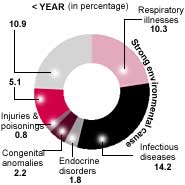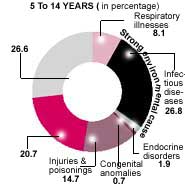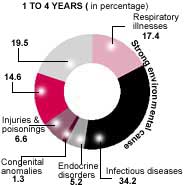Future was yesterdayAccording to the World Health
Organisation, globally environmental hazards kill three million children under five every
year
Environmental health threats include inadequate
drinking water and sanitation, air pollution, accidents, injuries and poisonings
In India, child mortality rates due to
environmental hazards and toxins are on the rise
55 per cent of child mortality originates in the
perinatal period
Our children’s future depends on our past. Grim, but true.
Environmental degradation of the past impacts the very air
that the children breathe, the water that they drink and the food that they eat.
Children are humankind’s most treasured investment. In
fact, sustainability (and future) of any species depends on the quality of progeny it
produces. However, the quality of progeny is affected by the environment that they are
born into and the environment in which their parents lived in. Children, especially the
unborn, are most vulnerable to any form of pollution. Even minor impact on health of the
parent particularly the mother threatens the health of the child, which manifests later as
poor health in adulthood. The recently concluded World Health Organisation (WHO)
conference on children’s health in Bangkok estimated that globally, environmental
hazards kill three million children under five every year. And this is a very conservative
estimate.
More
vulnerable
There is increasing evidence that foetal growth is the most
important aspect of life for any child. Foetal lung growth studies indicate that abuses
such as smoking and hazards such as ambient air pollution can result in reduced lung
function. But most exposures that occur in a mother and young children are accidental.
Plastics and plasticisers, dioxins, pesticides, and other chemicals invade the body
through every possible portal of entry. The growing evidence of invasive chemicals that
impair or retard growth of children is overwhelming. Often these substances work in
bewildering new combinations that are difficult to analyse. Consequently, there is an
upsurge of pediatric cancers, neurological impairments, mental retardation, low birth
weight and chronic anaemia and still births (see table: Dangerous
pollutants). Children are particularly susceptible to environmental
hazards because they consume more food and fluids (volume by volume), inhale more air and
constantly explore their environment. This means that more pollutants accumulate in their
bodies, which may immediately begin to impair normal development or cause unexplained
syndromes as children grow.
Children
are particularly susceptible to environmental hazards because they consume more food and
fluids and inhale more air |
In India, children have to bear the double burden of
diseases that have persisted for generations as well as of new diseases caused by various
environmental factors. In rural India, a mother is most likely to be anaemic or
malnourished. She works for long hours in smoke-filled kitchens and in the field. The
constant assaults of both traditional diseases such as diarrhoea, malaria and other
infectious diseases etc., and modern diseases caused by poisoning and contamination by
pesticides and fertilisers in dusts, air, water and food, plastic wastes, agricultural or
industrial effluents etc., make her specially vulnerable to a range of infections. This
affects the unborn foetus as well. In urban India, another emerging challenge are the
lifestyle-related diseases such as diabetes, attention-deficient disorders and obesity
that are also on the rise, as urban children are getting addicted to "junk" food
with little or no nutritive value and are leading an increasingly sedentary life.
| Dangerous pollutants |
| Pollutant |
Source |
Health effect |
| Endocrine disruptors (chemicals like dioxins,
polychlorinated biphenyls- PCBs, pesticides -dichlorodiphenyl trichloroethane-DDT,
dieldrin,lindane, etc) |
Food, human milk, water |
Cancer, immune system dysfunction, delayed neurological
development, low birth weight babies, abnormalities of the reproductive tract |
| Benzene, polyaromatic hydrocarbons |
Vehicle exhaust, indoor pollutants like biomass burning,
cigarette smoke |
Asthma, bronchitis, reduced lung function, other
respiratory illnesses |
| Heavy metals (lead, mercury, chromium etc) |
Soil, air, water |
Neurological impairments, mental retardation |
| Asbestos |
Air and water |
Lung cancer and respiratory illnesses |
The Health Information of India reports show that environmental reasons are
increasingly responsible for increased mortality in women and children (see graphs: What
kills India’s children…).
According to the report, 55 per cent of child mortality in India is due to conditions
originating in the perinatal period. A significant proportion of the other 45 percent, as
shown in the table, are strongly related to environmental causes. But this data is only
that of recorded deaths. The World Health Report (1999) of the WHO shows that 429,000
children in India die every year due to childhood diseases (pertussis, polio, diphtheria,
measles and tetanus) alone. This estimate is about three times the figure given in the
Health Information of India report.
Price of development
There is little doubt that modern development has occurred due
to rapid growth in the discovery and use of new chemicals. But many of these chemicals are
neurotoxic in nature, affect the brain and interfere with the workings of the nervous
system. These substances have the ability to affect intelligence, language ability, and
attention span. Children are especially vulnerable to the effects of these neurotoxic
substances. They may cause behavioural and social adjustment problems as well as affect
mood. At very high doses, neurotoxins may produce such effects as coma, convulsions,
respiratory paralysis, and death.
While definitive numbers do not exist, estimates are that in the order of 100,000
chemicals are used in commerce worldwide; of these, 75,000 are registered in the United
States. Worldwide, more than one new chemical (including industrial chemicals, pesticides,
pharmaceuticals and food additives) is introduced into the environment every day. Only a
fraction of the new compounds are completely tested for their safety. Little is known
about carcinogenicity or other, often fatal, health effects for the majority of chemicals
in use today. In developed countries, chemical substances are loosely regulated by
technical and enforcement agencies. For example, as of 1984, 10 per cent of the pesticides
in common use in the United States had been assessed for hazards, while for 38 per cent
virtually nothing was known. As of 1997, between 1.5 and 3.0 per cent of the approximately
75,000 industrial chemicals in US commerce had been tested for carcinogenicity. The
problem in assessing chemical toxicity is that different age groups and sexes respond
differently to the varying levels of chemicals, and most of these outcomes manifest
several years later. Often, combinations of chemicals act overtly and insidiously to
produce confounding results. Despite being a serious threat, chemical and toxins are least
studied by the medical fraternity. Even basic investigation protocols and therapeutic
interventions are not developed.
What kills India’s children…
Environmental reasons are increasingly responsible for increased mortality in
children (excluding 55 per cent of perinatal conditions) |
 |
 |
 |
 Strong environmental cause: respiratory illnesses, infectious
diseases, endocrine disorders, congenital anomalies and injuries & poisonings Strong environmental cause: respiratory illnesses, infectious
diseases, endocrine disorders, congenital anomalies and injuries & poisonings |
 Moderate environmental cause: neoplasms, nervous system and
circulatory system Moderate environmental cause: neoplasms, nervous system and
circulatory system |
 Somewhat
moderate environmental cause: digestive system, genito-urinary system, blood
diseases and ill-defined symptoms Somewhat
moderate environmental cause: digestive system, genito-urinary system, blood
diseases and ill-defined symptoms
|
|
| Source: Anon 2000, Health
Information of India 1997 and 1998, Central Bureau of Health Intelligence, Ministry of
Health and Family Welfare, Government of India. |
Even when evidences of toxicity exist, the costs of
producing and developing viable, safer, non-toxic alternatives are prohibitive. Large and
wealthy companies from developed countries therefore build manufacturing units in
developing nations, to exploit the weak and corrupt regulation or enforcement regimes of
those nations. This ensures the continued production of hazardous chemicals and pollutants
outside the home country and puts people in developing nations at risk. Toxic products
that have been phased out, restricted in use or banned for production or import to
developed countries are then liberally marketed in developing and poor countries.
|

